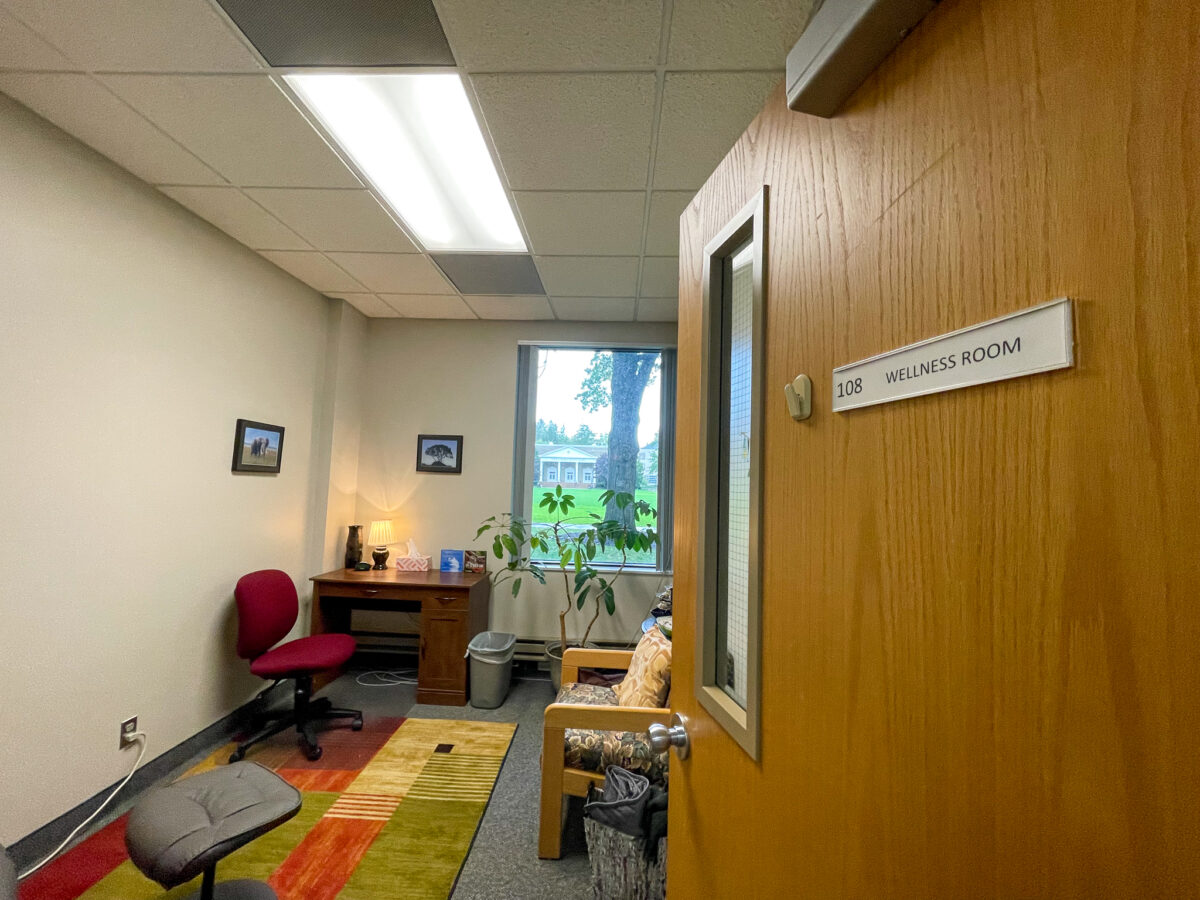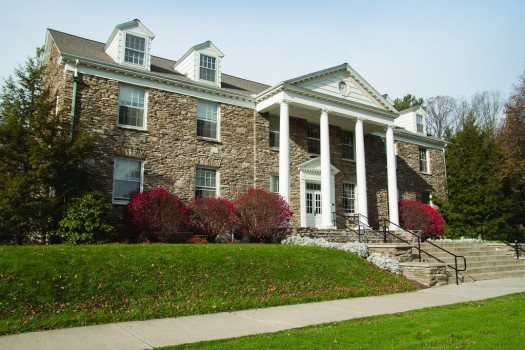By Marith Anderson
The Center for Student Success (CSS) is introducing a Wellness Room this semester that provides students with a safe place to take a break from the day-to-day stresses of college life.
Located on the counseling side of the CSS, the Wellness Room is equipped with various features and resources added to suit as many wellness needs as possible. “[This addition is] the result of our efforts to find creative ways to meet the needs of students,” explains Executive Director of the Center for Student Success and Director of Counseling Services Dr. Bill Burrichter. “The past few years have been really hard for students and we wanted to provide a comfortable and relaxing space where students could go to find rest, renewal and support.” With a record 33% of the student body coming through the Counseling Center last year, the need for other ways to meet students’ needs besides individual services became apparent.
When asked to describe the space, Center for Student Success Area Coordinator and Diverse Student Success Coordinator Hannah Bailey explained that “When you walk in you are greeted with a view of the quad and the soothing sound from our water fountain. Inside the room are a bunch of resources, so students should feel free to look around and explore the different things available to them. Some things the Wellness Room might be used for are telehealth sessions [- meeting virtually with one’s healthcare professional], scheduled self-care time, light box sessions [designed to combat Seasonal Affective Disorder and boost one’s mood], or just a space to relax.”
She added that resources currently available for student use in the Wellness Room include a massage chair, light boxes, a yoga mat, weighted blankets, journals, books, coloring books, a muscle relaxing mat, and more. Bailey is incredibly excited about and looks forward to what the Wellness Room could grow to be and is open to any suggestions students might have to help their needs be more effectively met within this space.
Students might be under the impression that the Wellness Room and its resources are only available to those who are currently utilizing other Counseling services, but this is not the case. In fact, even those who have no prior connections with any CSS service are able to engage with this new addition. However, Burrichter mentions that if needed, you can also connect with the CSS staff following your visit to the Wellness Room. He says that students “can come into the office and engage in some self-care as they need it without needing to connect with staff. But if they want or need to meet with someone we can arrange that as well.”
In addition to connecting with staff if needed, Burrichter further noted that there are additional resources students can connect with if they so choose. “We are also offering several sessions of an Anxiety Toolbox psychoeducational workshops for students to learn skills and strategies for managing their anxiety. We will also have future workshops on how to manage depression, stress and healthy relationships.”
So, how should one go about scheduling some relaxing time for themself in this space? When not in use, the Wellness Room is available for walk-ins. However, it is recommended that any students who are interested in using this space reserve a time slot of either 30 minutes or 60 minutes on the Handshake website or mobile app.
The Center for Student Success (CSS) is introducing a Wellness Room this semester that provides students with a safe place to take a break from the day-to-day stresses of college life.
Located on the counseling side of the CSS, the Wellness Room is equipped with various features and resources added to suit as many wellness needs as possible. “[This addition is] the result of our efforts to find creative ways to meet the needs of students,” explains Executive Director of the Center for Student Success and Director of Counseling Services Dr. Bill Burrichter. “The past few years have been really hard for students and we wanted to provide a comfortable and relaxing space where students could go to find rest, renewal and support.” With a record 33% of the student body coming through the Counseling Center last year, the need for other ways to meet students’ needs besides individual services became apparent.
When asked to describe the space, Center for Student Success Area Coordinator and Diverse Student Success Coordinator Hannah Bailey explained that “When you walk in you are greeted with a view of the quad and the soothing sound from our water fountain. Inside the room are a bunch of resources, so students should feel free to look around and explore the different things available to them. Some things the Wellness Room might be used for are telehealth sessions [- meeting virtually with one’s healthcare professional], scheduled self-care time, light box sessions [designed to combat Seasonal Affective Disorder and boost one’s mood], or just a space to relax.”
She added that resources currently available for student use in the Wellness Room include a massage chair, light boxes, a yoga mat, weighted blankets, journals, books, coloring books, a muscle relaxing mat, and more. Bailey is incredibly excited about and looks forward to what the Wellness Room could grow to be and is open to any suggestions students might have to help their needs be more effectively met within this space.
Students might be under the impression that the Wellness Room and its resources are only available to those who are currently utilizing other Counseling services, but this is not the case. In fact, even those who have no prior connections with any CSS service are able to engage with this new addition. However, Burrichter mentions that if needed, you can also connect with the CSS staff following your visit to the Wellness Room. He says that students “can come into the office and engage in some self-care as they need it without needing to connect with staff. But if they want or need to meet with someone we can arrange that as well.”
In addition to connecting with staff if needed, Burrichter further noted that there are additional resources students can connect with if they so choose. “We are also offering several sessions of an Anxiety Toolbox psychoeducational workshops for students to learn skills and strategies for managing their anxiety. We will also have future workshops on how to manage depression, stress and healthy relationships.”
So, how should one go about scheduling some relaxing time for themself in this space? When not in use, the Wellness Room is available for walk-ins. However, it is recommended that any students who are interested in using this space reserve a time slot of either 30 minutes or 60 minutes on the Handshake website or mobile app.
The Center for Student Success (CSS) is introducing a Wellness Room this semester that provides students with a safe place to take a break from the day-to-day stresses of college life.
Located on the counseling side of the CSS, the Wellness Room is equipped with various features and resources added to suit as many wellness needs as possible. “[This addition is] the result of our efforts to find creative ways to meet the needs of students,” explains Executive Director of the Center for Student Success and Director of Counseling Services Dr. Bill Burrichter. “The past few years have been really hard for students and we wanted to provide a comfortable and relaxing space where students could go to find rest, renewal and support.” With a record 33% of the student body coming through the Counseling Center last year, the need for other ways to meet students’ needs besides individual services became apparent.
When asked to describe the space, Center for Student Success Area Coordinator and Diverse Student Success Coordinator Hannah Bailey explained that “When you walk in you are greeted with a view of the quad and the soothing sound from our water fountain. Inside the room are a bunch of resources, so students should feel free to look around and explore the different things available to them. Some things the Wellness Room might be used for are telehealth sessions [- meeting virtually with one’s healthcare professional], scheduled self-care time, light box sessions [designed to combat Seasonal Affective Disorder and boost one’s mood], or just a space to relax.”
She added that resources currently available for student use in the Wellness Room include a massage chair, light boxes, a yoga mat, weighted blankets, journals, books, coloring books, a muscle relaxing mat, and more. Bailey is incredibly excited about and looks forward to what the Wellness Room could grow to be and is open to any suggestions students might have to help their needs be more effectively met within this space.
Students might be under the impression that the Wellness Room and its resources are only available to those who are currently utilizing other Counseling services, but this is not the case. In fact, even those who have no prior connections with any CSS service are able to engage with this new addition. However, Burrichter mentions that if needed, you can also connect with the CSS staff following your visit to the Wellness Room. He says that students “can come into the office and engage in some self-care as they need it without needing to connect with staff. But if they want or need to meet with someone we can arrange that as well.”
In addition to connecting with staff if needed, Burrichter further noted that there are additional resources students can connect with if they so choose. “We are also offering several sessions of an Anxiety Toolbox psychoeducational workshops for students to learn skills and strategies for managing their anxiety. We will also have future workshops on how to manage depression, stress and healthy relationships.”
So, how should one go about scheduling some relaxing time for themself in this space? When not in use, the Wellness Room is available for walk-ins. However, it is recommended that any students who are interested in using this space reserve a time slot of either 30 minutes or 60 minutes on the Handshake website or mobile app.★


